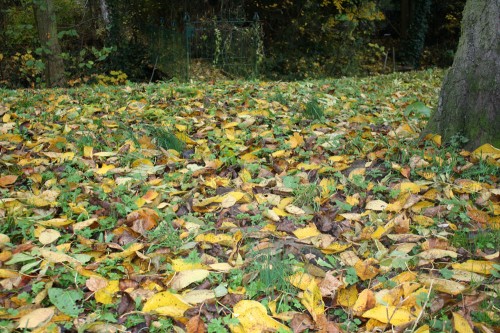Although many things outdoors have begun to whither and die back, some wild herbs are still thriving…and possibly even becoming easier for you to find. Types of wild garlic and chives are one example. Can you spot the clumps of wild garlic in the photo below? I know it’s not easy but you can click on the photo to make it larger also.
Did you find it? See the darker green clumps sprinkled around the photo? That’s the stuff. There are three clumps in the photo above/below. It’s a bit hard to see with all the leaves but it generally grows faster than the grass around it and has a distinctly darker green color.
This type of wild garlic is a bit like chives. It grows in long, tubular pieces and if you dig a bit up, you will find little bulbs on the bottom. It also has a very mild garlic aroma to it.
The particular area where this garlic grows near us is a public orchard where everyone walks their dogs. Makes me think twice about how vigilantly I will wash this before eating it. But it’s very hardy and comes back year after year. I do intend to transplant a bit to our garden, though, so I can control what sort of “fertilizers” it’s getting.
This is the same area where I harvested several pounds of acorns to use for acorn flour. I have yet to make the flour with them and see how it tastes, but I at least have about half of them ready for grinding.
There are also wild mushrooms that grow around this area but unfortunately none of them seem to be edible. Some of them which we’ve checked in our mushroom guide book are downright poisonous.
Next year we’re going to harvest elderberries from the area and maybe some of the plums too finally…although they may not produce anything at all next year as many of them are on a two year cycle. I’m still looking for walnut trees and nice blackberry patches.
What sort of wild foods and herbs have you found and harvested locally to supplement your own food supply?






Near where we live, there is a wonderful place to go walking…foresty and next to a river…it’s called the Waldnaabthal. We take Charlie, our dog there loads (moreso before baby), but the last tome we were there, I discovered that this area is completely laden with wild blueberries! It was pretty awesome. If we wanted a snack, we just bent over and picked some up. Charlie figured out what we were doing and he started picking his own blueberries…pretty funny. I’m going to have to keep an eye out for the wild garlic though! Oh, and we’ve got loads of edible mushrooms around here too. 🙂